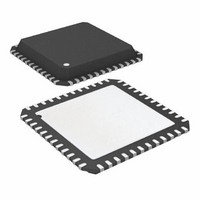ADUC7034BCPZ-RL Analog Devices Inc, ADUC7034BCPZ-RL Datasheet - Page 21

ADUC7034BCPZ-RL
Manufacturer Part Number
ADUC7034BCPZ-RL
Description
IC,Battery Management,LLCC,48PIN,PLASTIC
Manufacturer
Analog Devices Inc
Series
MicroConverter® ADuC7xxxr
Datasheet
1.ADUC7034BCPZ-RL.pdf
(136 pages)
Specifications of ADUC7034BCPZ-RL
Core Processor
ARM7
Core Size
16/32-Bit
Speed
20.48MHz
Connectivity
LIN, SPI, UART/USART
Peripherals
POR, PSM, Temp Sensor, WDT
Number Of I /o
9
Program Memory Size
32KB (32K x 8)
Program Memory Type
FLASH
Ram Size
4K x 8
Voltage - Supply (vcc/vdd)
3.5 V ~ 18 V
Data Converters
A/D 2x16b
Oscillator Type
Internal
Operating Temperature
-40°C ~ 115°C
Package / Case
48-LFCSP
Lead Free Status / RoHS Status
Lead free / RoHS Compliant
Eeprom Size
-
Lead Free Status / RoHS Status
Lead free / RoHS Compliant
ARM7 Exceptions
The ARM7 supports five types of exceptions, with a privileged
processing mode associated with each type. The five types of
exceptions are as follows:
•
•
•
•
•
Typically, the programmer defines interrupts as IRQ, but for
higher priority interrupts, the programmer can define interrupts
as the FIQ type.
The priority of these exceptions and vector address are listed in
Table 9.
Table 9. Exception Priorities and Vector Addresses
Priority
1
2
3
4
5
6
6
1
The vectors for the exception modes listed in Table 9 are
located at Address 0x00 to Address 0x1C, with a reserved regis-
ter at Address 0x14. Location 0x14 must be written as either
0x27011970 or the checksum of Page 0 (excluding Location 0x14);
otherwise, user code does not execute and LIN download mode
is entered.
ARM Registers
The ARM7TDMI has 16 standard registers. R0 to R12 are used
for data manipulation, R13 is the stack pointer, R14 is the link
register, and R15 is the program counter that indicates the
instruction currently being executed. The link register contains
the address from which the user has branched (if the branch
and link command was used) or the command during which
an exception occurred.
A software interrupt and an undefined instruction exception have the same
priority and are mutually exclusive.
Normal interrupt (IRQ). This is provided to service
general-purpose interrupt handling of internal and
external events.
Fast interrupt (FIQ). This is provided to service a data
transfer or a communication channel with low latency.
FIQ has priority over IRQ.
Memory abort (prefetch and data).
Attempted execution of an undefined instruction.
Software interrupt (SWI) instruction. This can be used to
make a call to an operating system.
Exception
Hardware reset
Memory abort (data)
FIQ
IRQ
Memory abort (prefetch)
Software interrupt
Undefined instruction
1
1
Address
0x00
0x10
0x1C
0x18
0x0C
0x08
0x04
Rev. B | Page 21 of 136
The stack pointer contains the current location of the stack.
As a general rule, on an ARM7TDMI the stack starts at the
top of the available RAM area and descends, using the area as
required. A separate stack is defined for each of the exceptions.
The size of each stack is user configurable and is dependent on
the target application. On the ADuC7034, the stack begins at
0x00040FFC and then descends. When programming using high-
level languages, such as C, it is necessary to ensure that the stack
does not overflow. This is dependent on the performance of the
compiler that is used.
When an exception occurs, some of the standard registers are
replaced with registers specific to the exception mode. All
exception modes have replacement banked registers for the
stack pointer (R13) and the link register (R14), as represented
in Figure 11. The FIQ mode has additional registers (R8 to R12)
that support faster interrupt processing. With the increased
number of noncritical registers, the interrupt can be processed
without the need to save or restore these registers, thereby
reducing the response time of the interrupt handling process.
More information relative to the programmer’s model and the
ARM7TDMI core architecture can be found in the ARM7TDMI
technical manual and the ARM architecture manual, available
directly from ARM Ltd.
Interrupt Latency
The worst-case latency for an FIQ consists of the longest possible
time for the request to pass through the synchronizer, for the
longest instruction to complete (the longest instruction is an
LDM) and load all the registers including the PC, and for the
data abort entry and the FIQ entry to complete. At the end of this
time, the ARM7TDMI executes the instruction at Address 0x1C
(the FIQ interrupt vector address). Therefore, the maximum FIQ
latency is 50 processor cycles, or just over 2.44 μs in a system
using a continuous 20.48 MHz processor clock.
USER MODE
R15 (PC)
CPSR
R10
R11
R12
R13
R14
R0
R1
R2
R3
R4
R5
R6
R7
R8
R9
SPSR_FIQ
Figure 11. Register Organization
R10_FIQ
R11_FIQ
R12_FIQ
R13_FIQ
R14_FIQ
R8_FIQ
R9_FIQ
MODE
FIQ
SPSR_SVC
R13_SVC
R14_SVC
MODE
SVC
SPSR_ABT
R13_ABT
R14_ABT
ABORT
MODE
USABLE IN USER MODE
SYSTEM MODES ONLY
SPSR_IRQ
R13_IRQ
R14_IRQ
MODE
IRQ
ADuC7034
UNDEFINED
SPSR_UND
R13_UND
R14_UND
MODE












